1. Introduction
The working industry has been constantly reshaped by technology, continually changing the world of work and the need to perform a set of routine tasks, while creating new jobs in more skilled areas. Generative AI is the next major wave of technology that moves beyond office tasks. Generative AI can now generate solutions, articulate ideas and engage in complex discussions, of which were originally thought to remain within the human realm of work. This brings us to the questions of which areas of work will shrink, which areas will become more important and how workers, companies and governments will try to react.
2. Historical patterns of technological disruption
Throughout history, wherever new sets of efficiency-improving work-related technologies are implemented on a broad scale, demand for human jobs and labor in monotonous and repetitive work appears to be slowly drained. Whether it is the mechanicalization of farming tools during the agricultural revolution, the industrialization of factories and machines in the 19th century, or the computerized digital era in the late 20th and early 21st centuries, the demand for traditional types of hour-intensive, clerical jobs has decreased. With the changing of each era, the demand for alternative types of management jobs increases, such as the spike in demand for software developers and data analysts during the 20th century's era of computerization. With each wave of innovation advancements, the required role of jobs shifts and transforms, necessitating adaptation.
2.1. Creative destruction and innovation cycles
With each wave of technological advances, the labor market is reshaped, leading to discussion of how to interpret and predict the significance of innovations like generative AI. Classic economic theory helps exemplify this, showing how market transformations are driven by steady improvements in the tools that support daily work. Joseph Schumpeter argued that innovation not only creates new industries but also destroys old ones [1]. When new technologies emerge, existing products, services, and jobs can become obsolete, while entirely new occupations arise in their place. This “creative destruction” may bring short-term job loss, but in the long run it can drive growth, productivity, and broader employment opportunities [2].
The age of electrification in the late 19th century shows this dynamic as well. As electric lighting spread, demand for candle makers and lamplighters declined. At the same time, electricity improved quality of life and generated new jobs such as electrical engineers, appliance manufacturers, utility workers. It set the groundwork for future industries like household appliances, refrigeration, and mass communication. This shows how technological progress reduces certain kinds of work while opening new opportunities in others [1].
2.2. Skill-biased technological change
Skill-biased technological changes happen when new technologies benefit high-skilled workers much more, requiring more mental effort, while reducing the need for lower-skilled workers in labor-intensive and repetitive jobs. Skill-based changes occur when these technologies make skilled workers who are usually more educated and experienced to be more productive.Skill-biased technological changes occur when technologies start to skew the benefits disproportionately, favoring high-skilled workers who require more brain-intensive workloads while reducing demands for lower-skilled workers on jobs that are more labor-intensive and repetitive. Skill-based changes occur when new technologies make skilled workers, who typically have more education and expertise in their respective fields, more productive. This presents itself as aid in their work, thus increasing their wages as well as job opportunities, and increasing the number of skilled laborers interested in these opportunities. However, due to the skill level bias, lower-skilled workers who perform routine tasks are more likely to be replaced by automation [3]. This, in turn, leads to increased structural unemployment due to their failure to adapt to changes in the type of labor demanded. Starting in the 1980s, the rapid adoption of computers for daily use had a revolutionary effect on how office work was done in businesses and homes. This wave of change led to dramatic shifts in labor demands, favoring employees who had the skills to operate, maintain, and efficiently use these new tools to automate previously time-consuming and tedious work [2]. Due to the widespread adoption of computers, computer literacy skills have become essential, with employers seeking workers who can navigate databases and use Microsoft Office skillfully. Skills in system management and programming have become increasingly crucial, alongside data analysis, as businesses require individuals to maintain and develop software to manage files, thereby enhancing both productivity and user experiences. These shifts ultimately had the effect of harming the traditional jobs of typists and secretaries, who once performed clerical tasks [3].Traditional bookkeepers and data entry clerks also faced reduced demand as software increased the accuracy and productivity of recording transactions or information while simultaneously mitigating errors and automating systems to process and store data at a faster rate.
2.3. The uniqueness of generative AI
What sets generative AI apart from previous waves of technological advances is that, unlike previous changes that were about physical, routine-styled labor, Generative AI has the power to conduct tasks that were previously considered human-only. While traditional automation was limited to assembly line jobs or helped lay the groundwork for data processing, Gen AI has the power to perform creative and analytical tasks, and sometimes even functions as a communicative tool designed to mimic previously deemed “human” actions. While traditional automation was confined to assembly line jobs or helped lay the groundwork for data processing, Gen AI has the power to perform creative and analytical tasks, even sometimes functioning as a communicative tool designed to mimic previously deemed human actions. Large language models train on vast amounts of existing data, allowing them to utilize deep learning models and transformer networks that help process text and comprehend it, then generate relevant responses, mimicking human language [3]. LLMs are further enhanced by Retrieval Augmented Generation (RAG), a technique that enables LLMs to utilize information from external sources. RAG enables the swift retrieval of relevant information from databases/documents, facilitating the process before generating a comprehensive response. This technology allows LLMS to provide more accurate, contextually relevant answers while remaining thoroughly up to date with rapid changes [4]. Due to LLMs and RAGs, these models can alter the "safety" of prior deemed human professions, such as the roles that paralegals, entry-level analysts, and junior software engineers may have previously served [5]. By breaking down these job tasks into predictable patterns and paths that have been previously successful, AI can replicate such professions with higher degrees of accuracy and at an increased rate as well. An example is the use of Gen AI tools to conduct summarization of long documents, such as legal texts and court rulings, rather than previously relying on entry-level law graduates.
3. Labor market impacts of generative AI
With the existence of generative AI, automation trends are expected to be further accelerated. In McKinsey’s analysis, it projects that by 2030, the technology could have the effect of automating up to 30% of the hours worked in the US economy, thus significantly shifting the job market’s labor demand. Generative AI has the power to not only automate manual routine work but also enhance cognitive tasks, such as data analysis. This supports the concept of skill-biased technological change, but now GenAI has an impact on higher-skill tasks as well [3]. The report speculates that the overall market trends indicate that demand for STEM, Law/business, and healthcare roles is expected to grow. In contrast, more clerical roles and some administrative jobs will begin to shrink.
Potentially, the largest category of hours that can be displaced is office support, reducing the demand by millions by 2030. Some high-risk areas highlighted in the report include customer service and sales jobs, where AI can handle simple inquiries, such as routine upselling, and troubleshooting with high efficiency [6]. This puts many of these service roles at risk. Office support roles are also heavily automatable because they are highly repetitive. Generative AI also threatens data processing jobs because it can categorize and summarize information much more quickly and with less human involvement than traditional methods. Changes like this do change both the number of jobs and the nature of the work. It changes many professions to require the use of AI tools and moderate AI. Shifts can lead to significant reductions in employment opportunities on a broad scale, unless the workers can transition to coexist and use AI to aid in their work efficiency, rather than have AI replace their jobs entirely [7].
3.1. High-risk roles and automation
The key issue is how generative AI will change the labor market by eliminating certain tasks and elevating the value of others. Historically, with each wave of technology, the demand for routine and repetitive tasks has declined while opportunities have opened up in new, higher-skill areas of work [3]. What distinguishes generative AI from other technologies is its ability to perform not only clerical work, but also analytical, creative, and communicative work that has traditionally been thought to be human-focused and human-unique. Some jobs in this context are the ones that revolve around clerical support, data entry, customer service, and even some entry-level legal, financial, and technological work. Conversely, AI raises the value of work that involves judgment, expertise, and people interaction. With generative AI, work is not being entirely replaced. Instead, it is being redefined. For example, in financial analysis, the task of simply collecting data was a mundane, tedious information-gathering exercise, whereas now it has higher-value work components that involve strategy and client engagement. In response to generative AI, companies should use AI to augment workers and not replace them, and invest in adequate training. Likewise, professionals must reinforce the “human skills” like critical thinking, creativity, interpersonal ability, and AI fluency that can't be easily automated. Governments can help by supporting the transition through education, retraining, and policy to improve the transition [8]. Generative AI makes skill-biased change a trend that is more rapid than the historical trend of "technology fits labor". Provided that we adapt these approaches carefully, they could be a source of productivity and innovation, offering new opportunities rather than being disruptive.
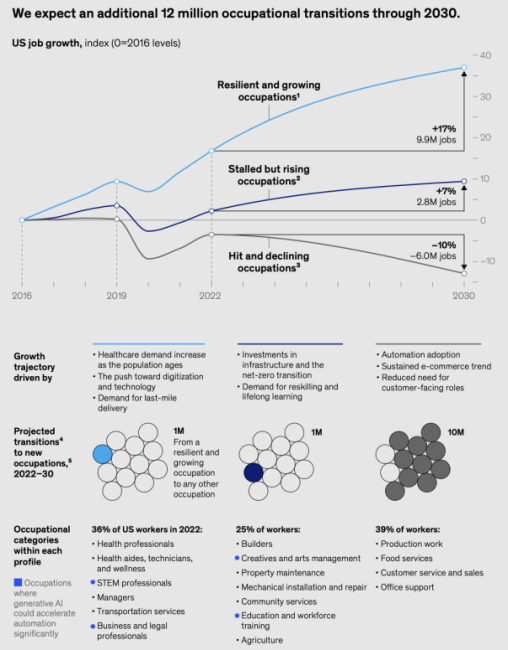
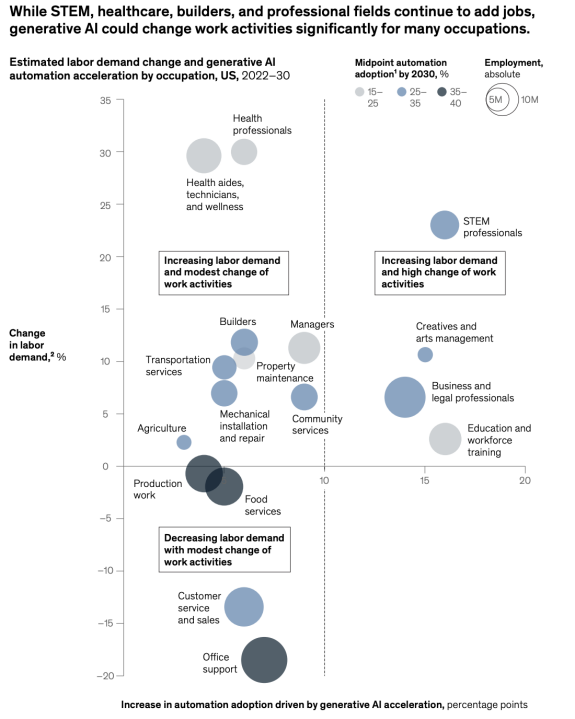
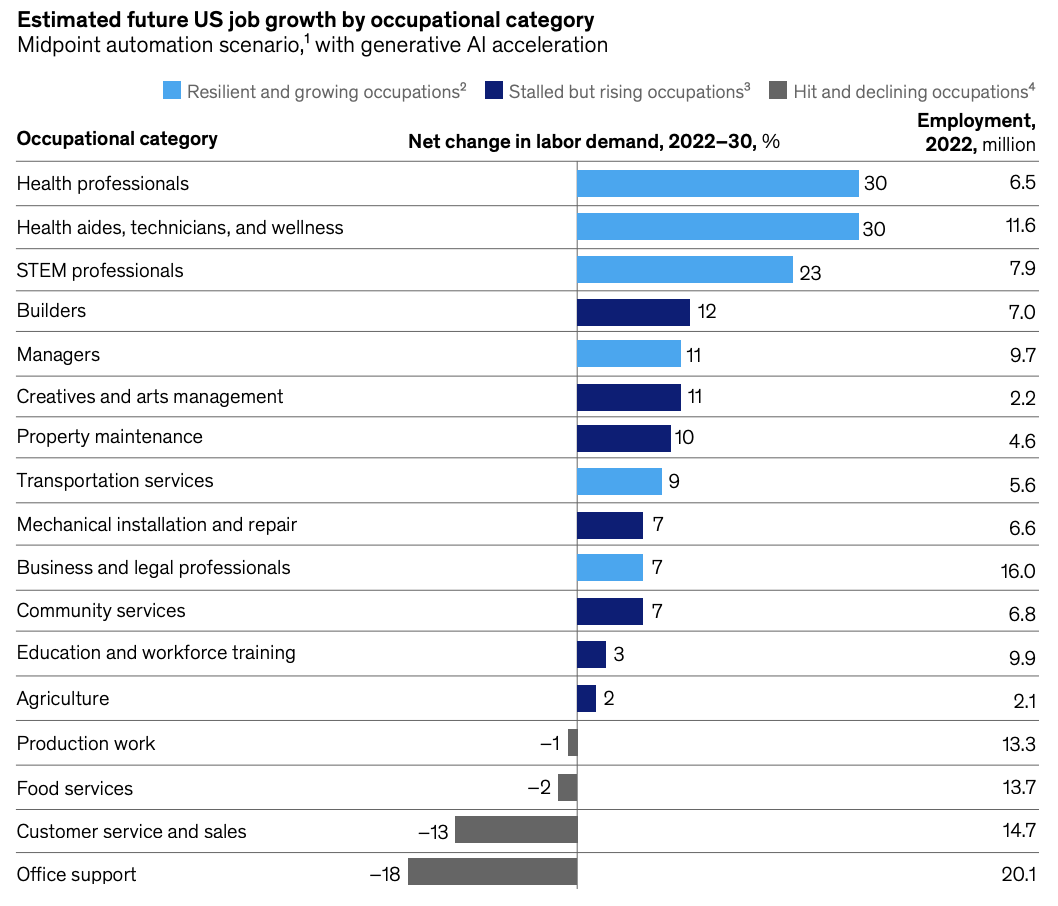
Figure 1. US Labor demand by occupation; expected to shift thru 2030 considering Gen AI automation acceleration
3.2. Newly-created jobs and automations
While AI advancement is often seen to be shutting out job opportunities, at the same time, Generative AI also has the opportunity of opening new and evolving roles [8]. With the rising reliance on AI, the topic of AI governance and ethics is an emerging critical topic, thus requiring the roles of specialists to assess and investigate the extent of responsible AI use without intruding into ethical dilemmas. Data analysis and the development of updates for AI are crucial, as they help produce higher-quality and more reliable outputs for users. AI can also alleviate portions of the burden from repetitive, tiring work, allowing people like healthcare workers to focus more on patient care.
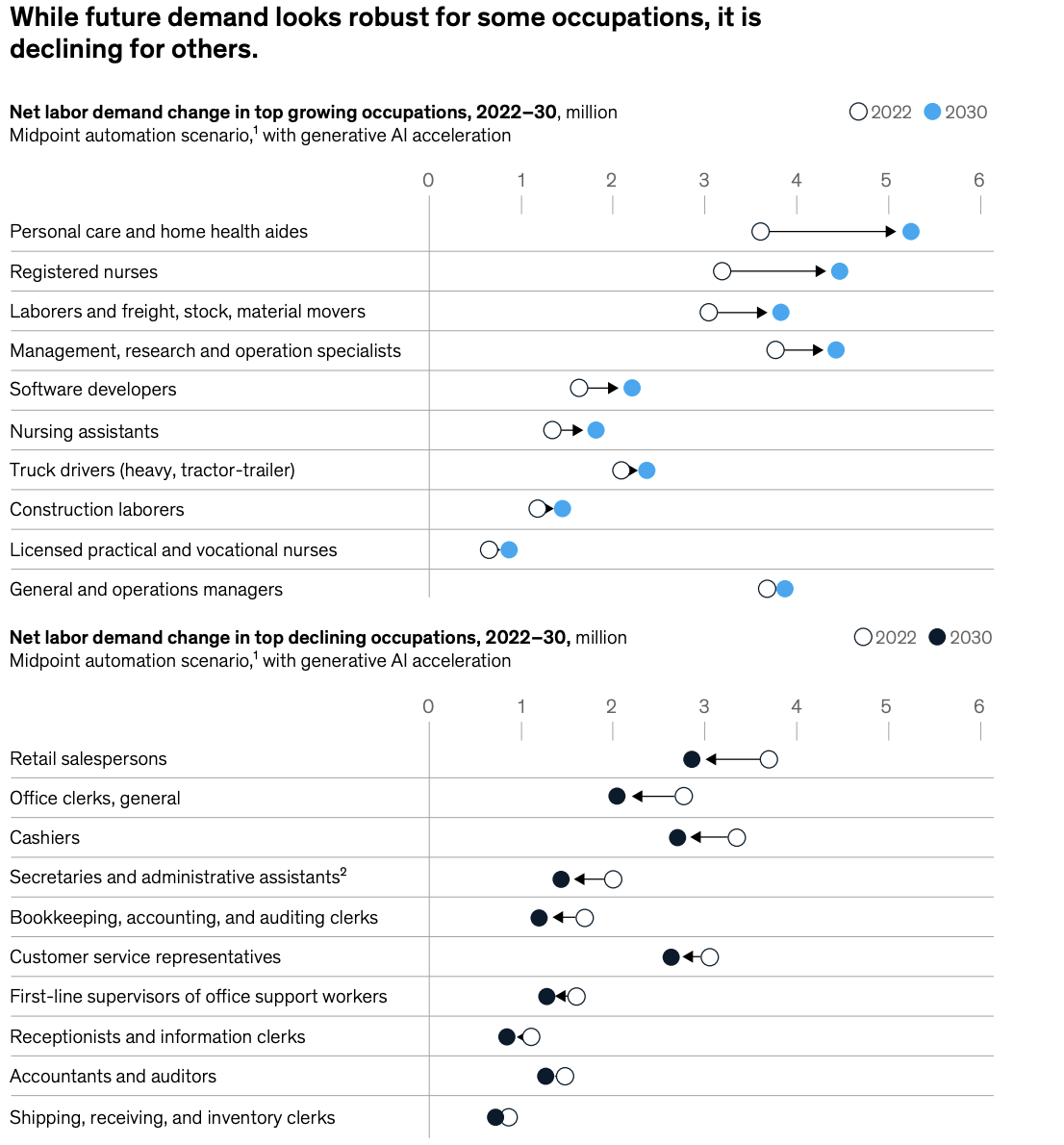
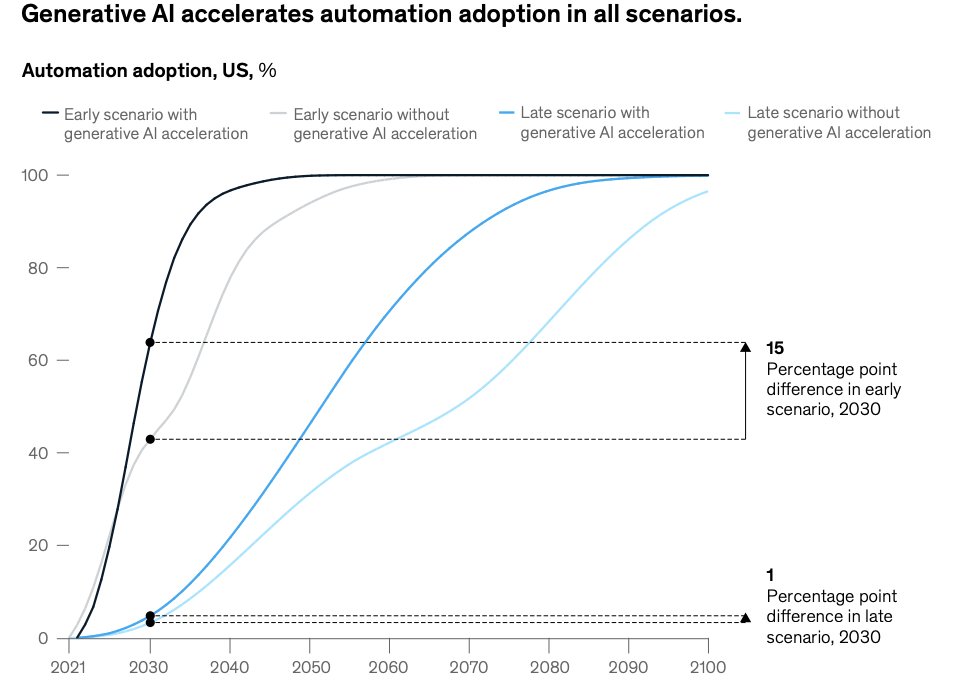
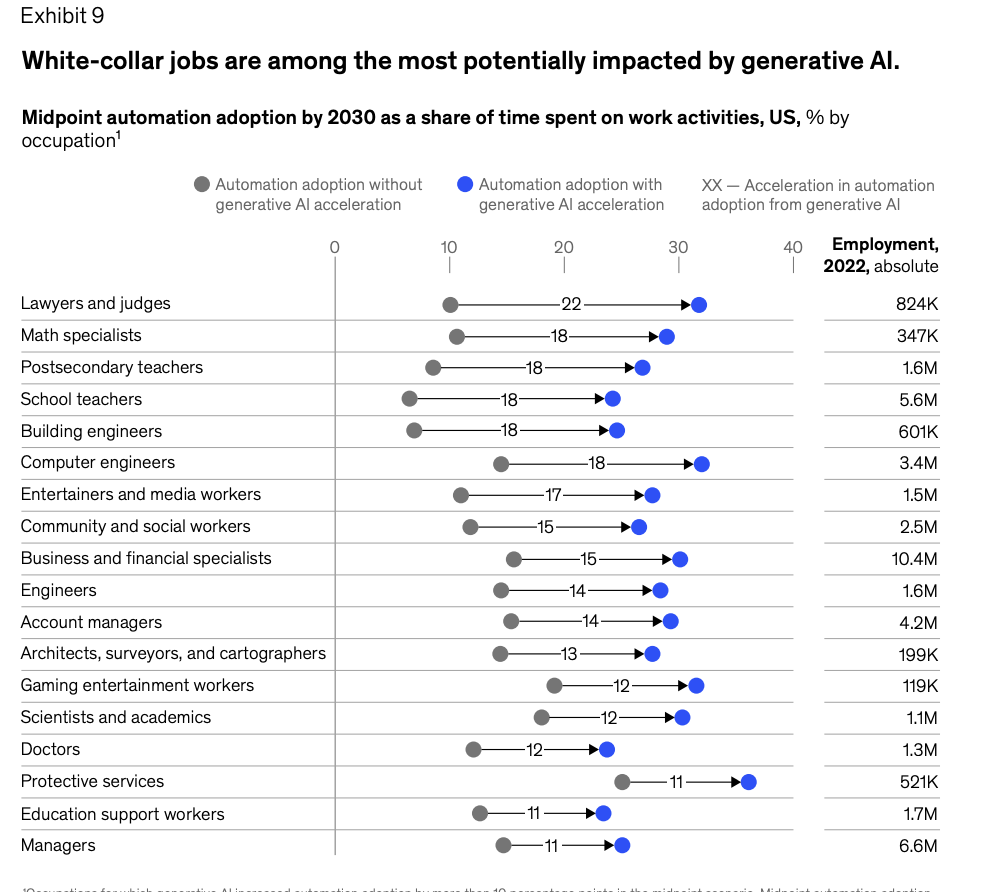
Figure 2. Job categories that are at risk or resilient under accelerated automation adoption
4. Case studies: GenAI in the investment industry
Based on this understanding of the displacement and creation of roles, the next step is to take a look at how it may unfold in various industries, particularly in the investment advisory field.
4.1. FinChat.io – automating analyst tasks
FinChat.io was designed to use Generative AI engines based on and trained on SEC filings, earnings transcripts, analyst reports, press releases, and market data to alleviate a significant drag on productivity in investment research: the process of collecting, summarizing, and making sense of detailed information before the real analysis work can begin. In the traditional structure, financial information is processed through junior analysts researching and spending countless hours of their week to pull together company data and cross-reference, manually transcribing everything to be later formatted into comprehensible reports. This data preparation tends to be error-prone and time-consuming, which is where FinChat.io can come in to help. This software enabled analysts to instantly retrieve relevant data and generate comprehensible reports with AI’s assistance, producing a written, professionally styled analyst search result. This software can automatically generate charts, summaries, and appropriate information that are presentation-worthy within seconds, completing tasks that would have previously taken 20-30 hours to complete in under an hour. This enables analysts to conduct a broader range of research and allocate more time to more intensive sectors. It shifts analyst jobs away from spending vast amounts of time in mechanical data gathering, and turns them into higher-value activities that are more human-bound. AI now has the effect of working as a support role, in which the workplace would need to learn how to generate effective prompts and utilize the efficiency and accuracy that bots like FinChat can bring.
4.2. Wealthfront – personalizing investment advice
Wealthfront is a robo-advisory platform that aims to automate tasks previously handled by human financial advisors. Wealthfront uses AI models to create and design possible investment portfolios for clients based on the goals and filters the client inputs, such as time horizons or risk preferences. Not only offering a more budget-friendly and efficient form of asset allocation recommendations, this AI can also answer client questions and rapidly formulate new suggestions/plans to balance holdings to reach the target asset mix. This AI constantly monitors performance and makes updates based on real-time data. What sets this tool apart is its integration of generative AI for client interaction, guiding clients to make decisions that are right for their circumstances. While some financial service providers require a high financial requirement before offering tailored services, this type of AI provides tuned responses without a bar to entry. Wealthfront’s system also has advanced tax strategies in which the AI can scan the portfolio for losses and then sell them off to offset taxable gain, all done without human intervention [9].
5. Conclusion
Generative AI is changing the job structure in the labor market similarly to how past technological waves reshaped production processes, although with important differences. In previous waves of technology, routine and repetitive tasks had decreased value as new higher skill opportunities for work emerged. With generative AI, we have new technology that is taking on not just clerical work, but also analytical, creative, and communicative work that people thought only humans could do. This means that jobs that are tied to clerical support, data entry, customer service, and entry-level professional assignments will be at the highest risk, while jobs that are dependent upon the human characteristics of judgment, expertise, and interpersonal skills will be valued more. For example, in the past, financial analysts focused on gathering the data that executives needed to make decisions; this has shifted to strategy and client relationship management. Organizations need to think about how to use AI to augment, not replace, their workers and invest in training. Workers will need to continue to cultivate their human skills of critical thinking, creativity, and interpersonal ability and develop fluency with AI models [7]. Governments can help with the transition through education systems, retraining, and policy levers. In this sense, generative AI is supercharging a long-standing trend of skill-biased change, and the transition can move us from being disrupted to becoming a driver of productivity, innovation, and opportunity.
Workers should take the initiative to acquire skills that will create opportunities in emerging areas, such as healthcare, STEM, logistics, and skilled trades. Those working should consider both technical training and developing their problem-solving, communication, and adaptability skills. When workers reskill early and remain open to workforce mobility, they will have a higher chance of getting into more stable jobs that pay better, rather than experience structural change that leaves them behind.
Employers should be thinking of automation as an aid to human skills, not a replacement. Automation can take away monotonous tasks and allow human talent to focus on strategy, collaboration, and creativity. To support this transition, companies must increase their investment in training/education, broaden their hiring approach to hire for skills and competencies instead of degrees, and expand their recruitment efforts to include those who are apt at utilising ai to ensure increases in productivity in the long run.
Public leaders can help aid this transition by increasing access to training programs and providing support. Policymakers must consider reskilling as infrastructure will ultimately help lead to upward mobility and inclusive growth. Increasing access to practical and flexible skill-building is critical. Policymakers should also support portable learning records so workers are able to take their skills with them across employers and industries. Additionally, removing barriers to access is equally important.
References
[1]. Carol M. Kopp(2025) Understanding Creative Destruction: Driving Innovation and Economic Change https: www.investopedia.com/terms/c/creativedestruction.asp/
[2]. Mark Dodgson, David Gann(2010) Joseph Schumpeter 's Gales of Creative Destruction. https: academic.oup.com/book/494/chapter-abstract/135261060?redirectedFrom=fulltext/
[3]. Daron Acemoglu(2002).Technical Change, Inequality, and the Labor Market.https: //www.aeaweb.org/articles?id=10.1257%2F0022051026976
[4]. Hartley, Jonathan and Jolevski, Filip and Melo, Vitor and Moore, Brendan, The Labor Market Effects of Generative Artificial Intelligence (December 18, 2024), https: //papers.ssrn.com/sol3/papers.cfm?abstract_id=5136877
[5]. Rick Merritt.(2025). What Is Retrieval-Augmented Generation, aka RAG?.https: blogs.nvidia.com/blog/what-is-retrieval-augmented/generation/#: ~: text=Getting%20the%20best%20performance%20for, least%20to%20the%20early%201970s.
[6]. Humza Naveed, Asad Ullah Khan, Shi Qiu, Muhammad Saqib, Saeed Anwar, Muhammad Usman, Naveed Akhtar, Nick Barnes, Ajmal Mian(2024). AComprehensive Overview of Large Language Models. https: //arxiv.org/pdf/2307.06435
[7]. Michael Klesel, H. Felix Wittmann(2025).Retrieval-Augmented Generation (RAG). https: //link.springer.com/article/10.1007/s12599-025-00945-3
[8]. Daron Acemoglu, Pascual Restrepo(2020).Unpacking Skill Bias: Automation and New Tasks. https: //www.nber.org/papers/w26681
[9]. The Investopedia Team.(2025) How Robo-Advisors Use Tax-Loss Harvesting to Boost Your Returns.https: www.investopedia.com/terms/r/robo-tax-loss-harvesting.asp/
Cite this article
Han,T. (2025). Traditional Theories VS Generative AI's Labor Market Impact. Advances in Economics, Management and Political Sciences,230,12-19.
Data availability
The datasets used and/or analyzed during the current study will be available from the authors upon reasonable request.
Disclaimer/Publisher's Note
The statements, opinions and data contained in all publications are solely those of the individual author(s) and contributor(s) and not of EWA Publishing and/or the editor(s). EWA Publishing and/or the editor(s) disclaim responsibility for any injury to people or property resulting from any ideas, methods, instructions or products referred to in the content.
About volume
Volume title: Proceedings of ICFTBA 2025 Symposium: Strategic Human Capital Management in the Era of AI
© 2024 by the author(s). Licensee EWA Publishing, Oxford, UK. This article is an open access article distributed under the terms and
conditions of the Creative Commons Attribution (CC BY) license. Authors who
publish this series agree to the following terms:
1. Authors retain copyright and grant the series right of first publication with the work simultaneously licensed under a Creative Commons
Attribution License that allows others to share the work with an acknowledgment of the work's authorship and initial publication in this
series.
2. Authors are able to enter into separate, additional contractual arrangements for the non-exclusive distribution of the series's published
version of the work (e.g., post it to an institutional repository or publish it in a book), with an acknowledgment of its initial
publication in this series.
3. Authors are permitted and encouraged to post their work online (e.g., in institutional repositories or on their website) prior to and
during the submission process, as it can lead to productive exchanges, as well as earlier and greater citation of published work (See
Open access policy for details).
References
[1]. Carol M. Kopp(2025) Understanding Creative Destruction: Driving Innovation and Economic Change https: www.investopedia.com/terms/c/creativedestruction.asp/
[2]. Mark Dodgson, David Gann(2010) Joseph Schumpeter 's Gales of Creative Destruction. https: academic.oup.com/book/494/chapter-abstract/135261060?redirectedFrom=fulltext/
[3]. Daron Acemoglu(2002).Technical Change, Inequality, and the Labor Market.https: //www.aeaweb.org/articles?id=10.1257%2F0022051026976
[4]. Hartley, Jonathan and Jolevski, Filip and Melo, Vitor and Moore, Brendan, The Labor Market Effects of Generative Artificial Intelligence (December 18, 2024), https: //papers.ssrn.com/sol3/papers.cfm?abstract_id=5136877
[5]. Rick Merritt.(2025). What Is Retrieval-Augmented Generation, aka RAG?.https: blogs.nvidia.com/blog/what-is-retrieval-augmented/generation/#: ~: text=Getting%20the%20best%20performance%20for, least%20to%20the%20early%201970s.
[6]. Humza Naveed, Asad Ullah Khan, Shi Qiu, Muhammad Saqib, Saeed Anwar, Muhammad Usman, Naveed Akhtar, Nick Barnes, Ajmal Mian(2024). AComprehensive Overview of Large Language Models. https: //arxiv.org/pdf/2307.06435
[7]. Michael Klesel, H. Felix Wittmann(2025).Retrieval-Augmented Generation (RAG). https: //link.springer.com/article/10.1007/s12599-025-00945-3
[8]. Daron Acemoglu, Pascual Restrepo(2020).Unpacking Skill Bias: Automation and New Tasks. https: //www.nber.org/papers/w26681
[9]. The Investopedia Team.(2025) How Robo-Advisors Use Tax-Loss Harvesting to Boost Your Returns.https: www.investopedia.com/terms/r/robo-tax-loss-harvesting.asp/









